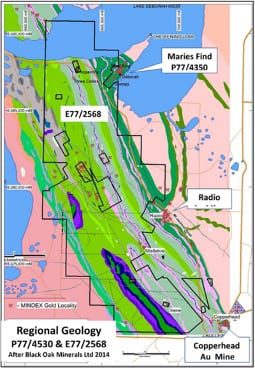Preparing For Early Test Of Maries Find Prospect
Enterprise Metals Limited (ASX: ENT) reports that its Maries Find – Bingin gold prospect on the peninsula in the Bullfinch North Project in the Southern Cross Greenstone Belt of Western Australia is drill-ready for RC testing in January 2021.
The Southern Cross Greenstone Belt has collectively produced more than 10 million ounces of gold. The major gold deposits such as Frasers, Marvel Loch, Nevoria, Great Victoria, Yilgarn Star and Copperhead (at Bullfinch) have produced the majority of these ounces. By comparison, the northern part of the Southern Cross Greenstone Belt (ie. north of Bullfinch) although containing many high-grade gold occurrences, has received very little modern exploration.
The Maries Find – Bingin Prospect is the first target to be drill tested in 2021. A Programme of Work (PoW) Id. 91856 to enable line clearing and RC drilling at Maries Find was approved by government officials in October 2020.
In May 2020, Enterprise announced that it had entered into a two year “Option to Purchase” agreement over various Bullfinch North tenements held by Nickgraph Pty Ltd, which includes the Maries Find – Bingin Prospect in P77/4350.
The Nickgraph tenement package stretches from Bullfinch in the south to Trough Well in the north and covers approximately 50 strike km’s (238 sq. km) of granted tenements over Archaean greenstone lithologies prospective for orogenic gold deposits, nickel-copper sulphide deposits, iron ore and pegmatite-hosted lithium.
Enterprise has compiled an extensive database of past exploration, identified a number of targets for further exploration and undertaken field trips to assess priority targets.
Gold mineralisation at Maries Find – Bingin predominantly occurs within lenticular quartz reefs and stringers within sheared and brecciated fault zones and lithological contacts. The vein at Great Bingin has a strike length of approximately 290m and is interpreted to be plunging to the north east.
P77/4350 lies within the basal section of the “Bullfinch greenstone belt” adjacent to the Maxman Dome granitic basement. Rock types include inter-bedded basic greenschists, basic lavas, and banded iron formations (BIF) of Archaean age. The majority of the greenstones are basic schists and are often brown due to biotite alteration adjacent to high grade gold mineralisation.
The dominant sulphide minerals associated with gold ores are pyrite and pyrrhotite with minor arsenopyrite and chalcopyrite as well as sporadic galena and scheelite. Gold occurs as free particles and as inclusions in pyrite and arsenopyrite, but the ore was not considered refractory when mined.
Two small open pit mining operations have been conducted over the line of lode. In 1985 Surina Pty Ltd undertook a trial open cut mining operation and extracted 188 t @ 12.8 g/t Au for 2.41 kg of gold from the surface crown pillar of the ”Great Bingin” mine.
In 1996, Western Union Securities Pty Ltd undertook a small mining operation over the Queen Marie area and extracted approximately 1,500 t of high-grade gold ore from a 25 metre deep pit. No detailed records of this work are available.












